














The new Carnage ™ III series rods are constructed from carbon or an e-glass and carbon blend, for an extremely powerful rod that leaves fsh begging. Yet it’s light enough to keep a fisherman going until the battle is won. Spec’d with high-end components like Fuji ® K-Guides, Sea-Guide ® and Fuji ® reel seats, plus a mix of hypalon/rubber shrink tube handles, the new Carnage III rod promises to be as ruthless as the name implies. PENN. LET THE BATTLE BEGIN ™ .
 ©2022 Pure Fishing, Inc.
©2022 Pure Fishing, Inc.

























Do you love boating? Then you know how fun and relaxing it can be on the open water. But you also know that things can go wrong sometimes, like storms, accidents, theft, or injuries. That’s why boat insurance is so important. Here are some reasons why.
• Boat insurance can help you pay for damage to your boat, or to other boats or docks, up to specifed limits.
• If you borrowed money to buy your boat, your lender may require insurance. And if you want to explore different places, some marinas or waterways may ask you to show proof of insurance.
• Boat insurance can also come in handy if you need an on-water tow, jump start, or fuel delivery with optional Sign & Glide® coverage. And if your boat sinks, boat insurance can pay for the cost of removing it from the water (if removal is legally required).
Get boat insurance from Progressive and enjoy the peace of mind that comes with it.
Scan to get a quote in as little as 4 minutes
Go to progressive.com to learn more.
If











Introducing The All-New NavNet TZtouchXL Series
Transform Your Helm Into A Multi Function Masterpiece





NavNet.com




Over the last few years, a burgeoning fshery has established the Gulf Stream out of Charleston as a big-time billfsh destination. Te ofshore trolling bite has been very good.
Capt. Mike Able keeps close tabs on the fshery. He and his brother, Graham, run Haddrell’s Point Tackle and Supply, a familyowned hunting and fshing store, which has grown to two locations and a fy shop in the Charleston area since their father, Mike Sr., started the business in 1983.


“Charleston has defnitely been put on the map with the billfshing we’ve had the last several years. It’s really been phenomenal,” Able said. “I mean, look at the Carolina Billfsh Classic. In the CBC last year there were outriggers full of sailfsh fags… we’re talking double-digit stuf. And not just the big boats. I mean, the big boats have an advantage, but guys are catching blue marlin from center consoles, too. You know the fsh are really chewing when the center-console guys are hitting fsh like that.”
Te Carolina Billfsh Classic (CBC) is one leg of the South Carolina Governor’s Cup Billfshing Series. It is held out of Mt. Pleasant each June. Last year, with poor weather
conditions during the one-day shootout, 47 boats released nine blue marlin and 53 sailfsh. Te top boat released four blue marlin. Te second-place boat released seven sailfsh and a blue marlin.
Able said conservation eforts, particularly from the Governor’s Cup, have led to healthier stocks. He also thinks anglers are getting better at fnding and catching billfsh. Te run outside the ledge is still 50 to 55 miles, but these days captains can go straight to potentially productive water. Satellite services make it easy to identify blue water, weed lines, temperature breaks and color changes to make a solid gameplan before leaving the docks. Additionally, technology like Omni Sonar can pinpoint fsh with an efective range of 5,000 feet.
“You could mark a fsh from a half mile away and go over and drop baits,” he said. “It doesn’t mean you can make them bite, but you know they’re in the area.”
Peak season for blue marlin and sailfsh is May and June, but blues will be in the area all summer. Sailfsh can be good into October or November, when wahoo enter the mix heavily. Able said a lot of marlin they catch are 150- to 200-pound “rats,” but they see some 300- to 400-pounders and an occasional 500-pluspound blue marlin. White marlin might also show up in a spread.
One of the perks of trolling out of Charleston in spring is you’ll also likely fll the box with dolphin and blackfin tuna. Capt. Able hung up his charter captain hat a few years back.
By Nick Carter
Now he fun-fshes with pretty remarkable success for billfsh and meat fsh by pulling a mixed spread with dredges, squid chains and circle-hooked ballyhoo from a ’34 Regulator.
Check out Haddrell’s Point Tackle & Supply at HadrellsPoint.com.


Instead of going “bottom fshing” this season, I would focus on going “grouper fshing”… at least for gags while the season lasts. You can go ‘bottom fshing” for the next seven months, but let’s put some gags in the boat while the law allows it! Here are some tips to help you bag some gags.
• Having the right bait is a major part of this puzzle. A pinfsh trap in a productive area for just a few hours and an (otter-proof) foating bait pen at the marina are priceless.
• You must anchor up or use the trolling motor in “spot lock” to properly fsh any piece of good bottom.
• When I frst post up on a good-looking mark on the recorder, I have everyone else on the boat fre down whole frozen squid on a jig. At the same time, I use a sabiki to catch whatever baitfsh are available on the structure. Here’s how it works:
1) Te squid might catch a handful “bottom fsh,” and maybe a grouper or two.
2) Most importantly, it sets a nice chum slick on the bottom that attracts the real predators of the structure directly under
your boat, and they will be ready to eat.
3) Afer four or fve volleys of squid, everyone baits up with a beautiful baseball-in-diameter-sized live bait and sends them back down to the bottom together. Tese baits are too big for most bottom fsh to get their mouths around.
4) Now, the grouper appear on the scene, curious about all the noise and the good smell. What do they see? Tey see a pinfsh from the marina or whatever came up on the sabiki. I like to fsh these baits on one of my Crab Decoy Jigs, which makes it look like the bait is struggling in the grasp of a hungry crab or squid. A big grouper, and especially a gag grouper, sees this as a Happy Meal. Tey love crabs, squid and baitfsh, and with this rig they think they’re getting it all in one bite.


5) An added bonus is that this is clean tackle, free of excess hardware, that sends the correct signal to grouper and results in bites.
• Te downside to this style of fshing is it will attract sharks. It’s all fun and games until the man in the gray suit shows up. Ten it becomes hard work. Sharks of all kinds are drawn to struggling snapper.
For more info on the jig, tackle and/or bait, check out Tim Barefoot’s YouTube channel and website at barefootcatsandtackle.com.





















 By Capt. Quinlyn Haddon
By Capt. Quinlyn Haddon
May 1 marks the reopening of Atlantic grouper season here in the Florida Keys. Over the past four months of season closure, a multitude of released catches taunted local fshermen, and now the hunt is ofcially back on!
While the Keys might not be well known for grouper, there is no reason why they shouldn’t be. Between the reef, wrecks and ofshore deep-dropping, the Keys are home to a plethora of grouper species. Te reopening of red, black, gag and snowy grouper vastly
increases fshing opportunities here in our Atlantic waters.
When fshing for grouper on the reef, keeping your rig from getting rockedup on the bottom is the biggest challenge. Do not overweight your rig, and keep an angler on or near the rod at all times. Grouper are notorious for grabbing a bait and taking it back into their homes immediately. When you lose a big grouper, especially with a mouthful of your tackle, they grunt a warning to the other fsh. Tis shuts down the grouper bite. It is best to keep the grouper rod in your hand when possible and be ready to crank them away from their hidey-holes. Tere isn’t much room or time for error on the initial bite.
Fishing for grouper over wrecks can also be highly productive. Amberjacks, which received a short closure in April, can be caught as bycatch while wreck fshing for grouper. Teir season also reopens in May.
Deep-dropping ofshore also expands greatly this month, as snowy grouper and blueline tilefsh reopen. Yellowedge grouper remains year-round, but even with large grouper hooks, tilefsh can be a frequent bycatch. Deep-drop rigs can be modifed this time of year to include smaller hooks that welcome the tilefsh bite and increase productivity of each drop.

Te abundance of mahi-mahi this month sweetens the deal for heading shore to deep-drop. Not only can you fsh for mahi-mahi on the route to, from and on your deep-drop numbers, you can also chase birds for a chance to read the bottom for new deep-drop spots. Tere is nothing quite like fnding a new fshing spot, and with so much in season right now, it is the perfect time of year to scout.
Remember to check fshing regulations, as there are ofen surprise closures on many species. Venting and descending tools are required when fshing for grouper and are especially important at the depths where snowy grouper are found. One look at the bug-eyed balloon face of barotrauma will tell you these fsh cannot return home safely without help. It is easy to go over a limit of snowy grouper by accident, so have your gear ready and know how to use it.
Sweet E’nuf Charters specializes in grouper and is already booking up quickly for the much anticipated reopening. Give us a call to get tight!
Capt. Quinlyn Haddon guides with Sweet E’nuf Charters out of Marathon, Florida Keys. Contact her at (504) 920-6342 or Captainquinlyn.com.
Find her on social @captainquinlyn.



Julia Bernstein, 12, of Miami, had a record-setting day fshing of Key West on Jan. 5. She set two new state records in a day by catching a 20-pound, 15-ounce cobia and a 1-pound, 8-ounce mangrove snapper while fshing with Capt. Dale Bittner.

Bernstein’s records were the frst two fsh certifed in Florida’s new saltwater record categories, which were launched in January. Tey both set the bar in the new Youth All-Tackle Weight category. Florida is also now recognizing state records for Youth and Adult Length Categories.
“‘Are those all cobia?’ I couldn’t believe it, as we pulled up to the wreck, there was a dark cloud on the surface of the ocean. Sure enough, it was a large school of hungry cobia, and they were ready to eat!” Bernstein said. She quickly hooked up to two smaller fsh, but in her words, “Tird time was the charm; it was an even larger cobia! We had a great afernoon, we caught six fsh from that school, one of which became the Florida state record and one of which is a pending IGFA Junior Record.”
Bernstein already holds 11 IGFA world records.
To fnish the day, they made one last stop, where Bernstein hooked up with her record mango.
“I worked hard to get it of the bottom and then reeled as fast as I could. Good thing I did, turned out to be a state record mangrove snapper!” she said.
Joseph Ingold set the bar for the redfsh length state record with an impressive 36.25-inch red he caught from a Kayak in Panama City in February. His story is of a slow day that turned exciting in a hurry.
“About halfway down, I hadn’t gotten a single hit, so I cast my paddletail and let it sink to the bottom while I grabbed a new lure to tie on. Once I got my new lure ready, I started to reel in my paddletail to switch it out,” he said. “About fve seconds afer I started to reel it back in, the redfsh hit.”
Ingold thought he had snagged the bottom, but then the fsh began to run.
“I got super excited and loosened up my drag at that point. I really didn’t want to break her of since I was only using 10-pound test,” he said. “When I landed the fsh, I honestly didn’t even think about submitting it for the new length record. I actively participate in the Catch a Florida Memory programs, so I just took pictures for myself and for the Reel Big Fish program. Afer I submitted for a Reel Big Fish, I was curious if anyone had submitted for the new length record and, to my surprise, it was still vacant. So, I took all the pictures I had and put in my application.” CALL

 By Mark Ambert
By Mark Ambert
You know spring has ofcially arrived when the eastern seaboard welcomes the arrival of voracious blackfn tuna! What better way to shake of the winter doldrums than to get out and target these small but mighty speedsters.
May and June are great months to target these fsh. Tey enjoy a wide range from Cape Cod to South Florida, and during the summer they migrate to temperate waters that remain above 70 degrees. Tey inhabit the warmest waters of all tuna species.
Blackfns are a schooling fsh and feed on migratory baitfsh, squid and shrimp. Tey frequently hunt the deeper side of the ledges and reefs common to the eastern seaboard. Tey commonly range from 5 to 20 pounds, with the occasional 30-pounder blowing up your bait!
Live bait is best for bigger tuna. I prefer goggle eyes, which can be caught or bought. Due to their hardiness, they are worth the cost to have on hand.
For live baiting, I use a Shimano Baitrunner OC size 6000 reel spooled with FINS 40G Braid. With the diameter of 6-pound mono, this braid has a tensile breaking strength of 45 pounds. I pair this reel with the Shimano Terez model TZS69M, 6-foot, 9-inch medium action spinning rod. I use a 6-foot section of Seaguar fuorocarbon in the 30-pound range for leader and Owner SSW 6/0 or 7/0 cutting point hooks. Blackfn are leader shy, so start with a 30-pound leader and move up to 40 only if you are experiencing breakofs.
I combine live bait with jigging techniques when targeting tuna. For high-speed retrieval of lures through the water column, which these fsh prefer, I use the Penn Battle III 4000 HS (high-speed) spinning reel. I pair this with a 6-foot, 6-inch Shimano Trevala B. I start of using Rapala Williamson Kensaki jigs in the 120- to 220-gram range.
Pro tip: Switch sizes and colors until you fnd what best “matches the hatch” rather than switching jigs.
I fsh early mornings, as tuna can be both light and boat shy. During a full moon cycle, the bite can turn of quickly as the fsh have been feeding most of the night. Once on my target area, I set up for a drif just outside the frst reef system, past the drop-of in deeper water to avoid bonito, sharks and kingfsh. Tis is typically in the 225- to 300-foot range. I deploy two live baits—one in the bow and the other in the stern—then jig in the middle. Check your fshfnder ofen to identify “scratches,” or fsh moving through, and mark the depth they appear in the water column. Target these fsh while jigging.
Te food quality of blackfn depends on proper bleeding when they are frst caught. Make a small incision behind the pectoral fn on both sides of the fsh to ensure the highest quality meat. Catching these speedsters will quickly become an addiction, and now is the time to make it happen!
Find Mark Ambert on Instagram @marksgonefshing_™; email: marksgonefshing25@gmail.com.











Whether considering repowering your trailer boat or your offshore beast, there is a Mastry Suzuki RePower Center that can serve your repower dreams. Mastry Suzuki RePower centers are the best in the business and have the experience, technical know-how and boating passion to make your repower project a remarkable success. With total boat systems capabilities your local Mastry Suzuki RePower Center can address all your upgrade aspirations. Essentially transforming your boat into a totally new boat at one single location.
With 15 Locations Across the Southeast There is a Mastry Suzuki RePower Center Near You.












*Get with the Program!



When you purchase a new Suzuki outboard from an authorized Mastry RePower Center you qualify to become a member of the Mastry Suzuki Owner’s Edge. Owners receive an identification card that provides them with important information about their Suzuki outboard motor as well as a passport to additional benefits during ownership. Members enjoy a detailed engine maintenance schedule, Mastry Suzuki RePower Trade Program and special pricing from Mastry Suzuki Partners.




Durable boat lifts expertly designed with Florida in mind.

ShoreStation hydraulic boat lifts are a reliable choice for coastal residents and boating enthusiasts alike. Their strong construction, made with corrosion-resistant materials, allows them to withstand harsh environmental conditions, including sun, storms, and saltwater damage. ShoreStation provides a steadfast solution for protecting waterfront investments, ofering peace of mind to owners in the Sunshine State.

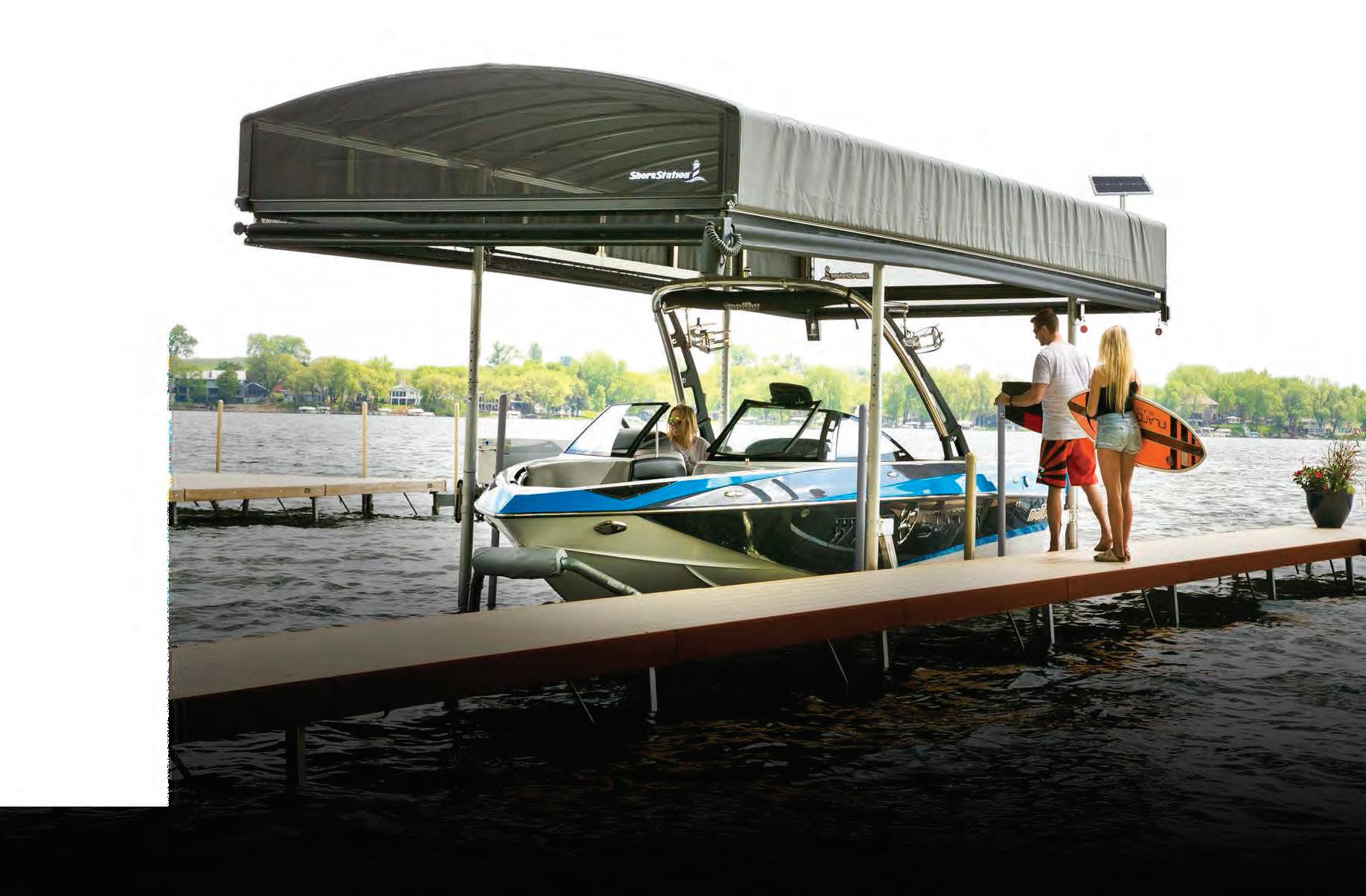




Equipped with exceptional weather resistant fabric and breathable SunTex 80 woven mesh ends for maximum protection and durability,

Made from the highest quality materials, our innovative hydraulic boat lift is one of the fastest and safest lifts on the market today. When you have a hydraulic lift, there’s no need to worry about wind and waves getting in your way. This lift will give you confdence to safely land and secure your boat in less-than-ideal conditions. No Piling Required

Never miss another moment on the water. Power your lift with clean, free solar power. Our speedy 20 watt charger features solar regulator drainage protection, saving your battery from permanent damage caused by overcharging.



Since early November, when the frst reports came in from the Florida Keys, scientists have been looking into reports of fsh exhibiting abnormal behavior referred to as “the spins.” Bonefsh & Tarpon Trust (BT&T) recently pointed its fnger at harmful algae as a likely reason for this phenomenon that has killed numerous endangered sawfsh and afected fsh of 30 diferent species.
Fish with the spins lose equilibrium and swim upside down in circles, ofen following a stressful or stimulating event. According to BT&T, a majority of reports for this behavior originated in the Lower Keys, between Big Pine Key and Sugarloaf Key, but there have been reports farther west toward Key West as well as in Miami north of Biscayne Bay National Park. Among the species afected are popular sport and food fsh such as tarpon, permit, snook, jack crevalle, mutton snapper, mangrove snapper, cubera snapper, goliath grouper and redfsh.
In January, BT&T and the Lower Keys Guides Association launched a study with the assistance of numerous other organizations to determine the cause of these events. BT&T stopped short of calling its results conclusive, because there’s still testing to be done, but they indicated occurrences of harmful algae blooms in the gambierdiscus family are the likely culprit.
Saltwater anglers will likely be familiar with ciguatera poisoning caused by the accumulation of ciguatoxin in predatory food fsh. Gambierdiscus is known to produce ciguatoxin and other neurotoxins that can have diferent efects on human and marine life. BT&T in not yet sure whether this variant of gambierdiscus is producing any cytotoxin that would move up the food web, but evidence indicates it is such a toxin that is afecting fsh.
Tese harmful algae are more common in reef areas that are environmentally stressed, according to BT&T. Testing continues and should hopefully provide more insight into this algae’s potential impact to the fsheries.
For more information, go to bonefshtarpontrust.org.









Saltwater fishing is a great adventure, with every cast bringing the promise of excitement and new memories. Whether you're exploring the serene shallows of inshore flats or delving into the depths of offshore wrecks, there's a world of possibilities waiting to be explored beneath the waves.
Among the abundance of resources used for bringing in fish, jigs stand out as a popular choice for enticing hungry critters. With their
vibrant colors, various sizes, and enticing styles, jigs offer an array of options to suit every angler's taste. It's no wonder they're a favorite among fishing enthusiasts worldwide, both inshore and offshore.
Recently, I spent some time jig fishing while strolling along the inshore mangroves of the Ten Thousand Islands. One lure to standout in my tackle box that trip was the Redfish Jig by Gulfstream Lures. With its eye-catching white and shiny red design, it was proven to be irresistible to the predators of the mangroves. From feisty Redfish to spirited Jack Crevalle and graceful Ladyfish, it seemed like everyone wanted a piece of the action. Nearby fish were lured in by the jig's quick movement and striking presentation, making for a fun day on the water.
When it comes to jig fishing in the mangroves, precision is key. We have to carefully position our vessel along the mangrove line, getting close enough to see the action but avoiding hitting the branches or scaring away fish. Once we’re in a good spot, I cast my line as close as possible and let it sink. I then employ a series of rhythmic bounces and pauses to mimic the movements of wounded prey, enticing nearby fish with every twitch.
Of course, navigating the winding channels of the mangroves comes with its own set of challenges. Oyster beds commonly lurk beneath the surface, posing a constant threat of getting stuck. But with a keen eye and steady hand, it’s easy to avoid them.
In t he end, it's not just about catching fish, but also about immersing yourself in the natural beauty of the mangroves. When I’m out there, away from devices and worries, it’s easy to forge a deep connection with the world around me. I bet plenty of fishermen can agree with me, especially those that fish inshore.
While you have the option of choosing between various artificial lures for mangrove fishing, consider jigs next time you go. The hard strike from a big fish that follows will be well worth it! So, grab your rod, tie on a jig, and enjoy the peace that jig fishing in the mangroves has to offer.

he months of May and June bring the most spectacular, natural displays of fish migration to SW Florida, especially in Boca Grande Pass (‘Pass’). The ‘World’s Biggest Tarpon Migration’, in all its splendor in our back yard! The ‘Pass’ becomes home to the best tarpon fishing on planet Earth. Whether a fisherman or not, the natural display of this wildlife beauty, at its finest, is worth a boat ride to the ‘Pass’ to witness. In May, thousands of these pre-historic fish make their appearance to mate, replenish, grow and survive.
This is the ‘Promise’ Land for big game hunters looking for the ‘Holy Grail’ or a ‘fish of a lifetime’. It is an experience of a lifetime to hook and land a huge tarpon. However, landing a tarpon is different from hooking one. Nonetheless, one will have a sense of gratitude once they experience the magnitude of the most fighting fish on the planet, if only for a short period of time! Many anglers try year after year with no success. The reason for failure is that it requires years of experience and knowledge to hook and land a silver king in the Pass. To do so requires one to re-learn to fish a totally new technique with nuances vastly different from all other presentations utilized for other inshore and offshore species. These huge fish are here to spawn and even though huge, have a gentle approach when it comes to eating a presentation. Understanding them makes all the difference in the world to be able to hook one up, let alone, land it.
I have spent the last 15 years learning the basics to take clients to Boca Grande Pass, to experience this awesome event. Over the years, I have hired and fished with the best Tarpon fishermen that I know to gain knowledge to provide the ultimate experience to those wanting to catch a huge tarpon. Fishing Boca Grande Pass is an experience within itself, it is not for the faint of heart or for those with physical disabilities.
Nonetheless, the title of my article is “Boca Grande Tarpon and Beyond” is just what it means! There are lots of opportunity for those that do not want to fish the ‘Pass’, but still want an opportunity to catch a tarpon of a lifetime! These fish will inhabit our estuaries from early April through June. The breeders are migrating for the Florida Straits up the Gulf of Mexico and will be anywhere from 50 yards off the beaches of the outer islands of Sanibel, Captiva, North Captiva, Cayo Costa as well as throughout Pine Island Sound and Charlotte Harbor. In contrast to fishing the intimidating Boca Grande Pass, other great options remain just offshore as well as in Pine Island Sound and Charlotte Harbor. During the northern Tarpon Migration, there are literally thousands of tarpon pods infiltrating our waters allowing a

more relaxing experience utilizing different techniques. Tarpon Hunters can avoid the crowded pass of Boca Grande and have an opportunity to enjoy and catch this superior fish species. Guides like myself fish both types of venues on a regular basis so as to accommodate both demanding and less demanding anglers. This being said, everyone can have a chance to catch their “Tarpon of a Lifetime”! Simply pick your pleasure and hire a guide with the qualifications to fulfill your requests.
Du ring May, tarpon are not the only predominate species that one may consider targeting. Even though snook season is closed in our area they can still be fished, caught and released. This is the second most sought after fish to tarpon. They are plentiful and are everywhere. I prefer to free-line live sardines, herring or pinfish using light tackle with circle hooks off the beaches, under docks along the passes of Boca Grande, N. Captiva and Sanibel.
Seatrout are back and here in good numbers and sizes as well. They are also available for harvest. Be sure and check the FWC Guidelines to comply with the law. Light tackle will give anglers plenty of satisfaction catching lots of these in 4 to 5 feet of water on shrimp under corks over the grass flats.
Spanish mackerel and pompano may provide optional enjoyment in the passes, just off the beaches as well as in the grass flats while fishing for seatrouts.
Offshore, the waters are warming up and one may find lane snapper and mangrove in 55 or less foot of water over rubble and manmade reefs. However, to get to the bigger snappers and groupers, expect to fish waters with depths of 85-120 feet for keeper(s). The water will continue to warm and the warmer it gets the deeper one needs to target reef species.
This is Captain Terry Fisher with Fish Face Charters. In addition to my boat, I am also available as ‘Captain for Hire’ on your vessel (by the hour) to teach safety, navigation, fishing techniques and locations to catch fish both inshore or offshore. Check out my website at www.fishfacecharters.com. Email me at fishfacecharters@yahoo. com or call me direct at 239-357-6829 to book a charter on your vessel or mine.
















Springtime is finally here! The snowbirds are packing up their cars and heading back up north, and the fishing is about to heat up!

We are already starting to see our spring/summertime fish show up, and the weather continues to get nicer each day. If you have been waiting to fish until the chaos of season is over, then it’s time to dust off your gear and get out on the water!
troughs up and down the coast. However, if you know what you’re looking for, you can have an awesome fishing session. For bait of choice, I prefer live pilchards or threadfins. Once you spot your intended target, make sure to cast ahead of the snook in the direction they are heading. Never cast directly on top of them, as you will spook the fish. A good rule to remember is that prey never swims towards a predator, so you don’t want to reel your bait back towards a beach-cruising snook. Instead, throw ahead of the fish, and have the bait presented in a way that the snook thinks it just happened to stumble across a wounded bait fish. This will greatly increase your hookups.
Offshore has been equally as good. We are seeing massive schools of permit showing up on the wrecks and reefs. One day last month we even stumbled across a school of big permit that had at least 500 fish in it. Bait of choice for permit is always crabs, but if you don’t know how to catch crabs you might have luck with a giant shrimp on a jig head. It doesn’t always work, but sometimes you get lucky. In addition to permit, there are schools of tarpon showing up as well. There aren’t a ton of fish here yet, but there are enough that its worth actively targeting them. Tarpon can be picky when it comes to bait, so I like to have both crabs and threadfins in the livewell to make sure I have all my bases covered. Kingfish have also finally showed up! After nearly two years without seeing a king, it’s nice to finally have these big, hard fighting fish back in the lineup of target species. If you are trying your luck at kingfishing, make sure that you know how to tie proper kingfish rigs, and always use steel leader.
The fishing has been great and should be amazing all spring! We will be here through the month of April, and then off to the Florida Keys for the month of May to fish the tarpon migration! If you have ever wanted to target big tarpon, give us a call and book a Keys tarpon trip! Spring is here, snowbird season is over, and it’s time to get into some serious angling!
The backwaters have been productive over the course of the last month. There are plenty of the usual suspects, i.e., redfish, trout and snook hanging around. As the water begins to warm up, snook will start to show up in large numbers. During the winter many snook move further back seeking warmer temperatures, some making it far up into nearly freshwater. As they make their way from their winter strongholds, be prepared to sight fish them from the beaches. This is one of my favorite types of fishing. When they hit the beaches, snook lose their brown/olive color backs and turn more silver/yellow. This makes them difficult for the untrained eye to spot as they cruise in the Pale Horse FC | palehorsefishingcharters.com | 239-285-7710












As the sun came up, the anticipation started for this little angler. A full day of fishing ahead. Can you guess one of his favorite fish? That’s right, snook! And to his surprise, he was about to have a day full of catching them back-to-back. As we all know, there’s good days and bad days of fishing. Lucky for us, Brayden doesn’t mind the small ones just as much as the big ones. He’s happy to just be fishing. From small ponds to the open ocean, Brayden will find a way to catch something. Pictured here, we were fishing with Mike Downs of Task Force Fishing Charters in Punta Gorda.

Mike was a great captain and wonderful with B! Brayden was able to catch as many snook as you can count of all sizes! Not bad for a 7-year-old. We tend to find ourselves fishing more times than not but when you see the happiness it brings to your children, it’s like the first time every time. As the day progressed, Brayden started getting more and more snook. He also had his first barb in the hand, but he took it like a champ. The day finally ended, and it was time to go home with a boat full of memories and smiles. Until next time! Happy fishing.














Spring is here and the beaches are a great place to spend a day or a few hours fishing in the Southwest Florida area. I prefer to walk along the surf looking for areas that may cause fish to hangout and I like to find areas where the sandbars are squeezing closer to the beach. Usually, those areas will have a little more current and slightly deep hole on either side of the bar. I prefer to have the surf churning, causing the waves to break on the bar stirring up the water along the beach. That type of action can cause fish like snook to hang around looking for a confused bait fish to make an easy meal of. Another advantage with sandbars being close to the beach is when a wave breaks many times it causes the water to foam up on the break and many times snook and other fish like bluefish, trout, spanish mackerel will come in after the break to feed on the confused bait. I like to cast after the break using a swimbait, spoon or other moving baits. The bait will be very confused, and the predators can be very aggressive. With the churned-up water the fish really don’t get a good look at your lure, and this can be a great opportunity to use artificial lures in the surf. Once again, the key is to cast just after wave breaks and the churning water causes the foam to the surface. Hopefully, you have a chance to fish our beautiful beaches, good luck and keep casting.














 Some nice cobia decided to come out to play w/ Capt. Billy Norris’s guests.
A nice tripletail caught off of Cortez. Steve, Dave, Penny, Kelly & Martin had a perfect day in Paradise on the gulf w/ Capt. Steve.
Nice kingfish!!
Earl Horecky using a fly rod for reds near Pineland.
Spencer from Northport caught this nice gag grouper night fishing, Venice.
Curt Graber w/ his PB African Pompano, 50 miles off of Siesta Key.
Macey with a nice backcountry Snook in Naples on a Redfish Rob’s Charter.
Some nice cobia decided to come out to play w/ Capt. Billy Norris’s guests.
A nice tripletail caught off of Cortez. Steve, Dave, Penny, Kelly & Martin had a perfect day in Paradise on the gulf w/ Capt. Steve.
Nice kingfish!!
Earl Horecky using a fly rod for reds near Pineland.
Spencer from Northport caught this nice gag grouper night fishing, Venice.
Curt Graber w/ his PB African Pompano, 50 miles off of Siesta Key.
Macey with a nice backcountry Snook in Naples on a Redfish Rob’s Charter.












Pasco County scallopers will get a 40-day season in 2024 afer the Florida Fish and Wildlife Conservation Commission approved a change to the management region during a February meeting. Te season for the Pasco County Zone will begin July 10 and run through Aug. 18, annually.
Tese long-term season dates were informed by the 2023 post-season monitoring results by FWC’s Fish and Wildlife Research Institute as well as input received from stakeholders at virtual public workshops, in-person meetings and public comments.
“Along with moving away from the Independence Day holiday, the longer season will increase both the public’s safety and access to one of our state’s most fun family resources,” said FWC Commissioner Preston Farrier. “ Tere will be many positive impacts for the local communities.”
Te Pasco Zone bay scallop region includes all state waters between the Hernando/Pasco county line and the Anclote Key Lighthouse in northern Pinellas County, and includes all waters of the Anclote River. For complete regulations, visit MyFWC.com/Scallops.












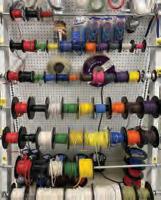
























 By A. deGruchy
By A. deGruchy

You’ll fnd some real giants lurking in Florida waters, ofen hanging out near wrecks, structures and mangrove roots. Te notorious Goliath grouper is a massive, territorial and iconic Florida fsh that has experienced a remarkable comeback in recent years, prompting the Fish and Wildlife Conservation Commission (FWC) to introduce a lottery system for limited harvest.
It’s been quite the journey for these giants of the sea. Back in the 1990s, they were critically endangered, and conservation eforts swung into action


to protect them. Trough the 2000s, Goliath grouper started reappearing in South Florida’s coastal waters in greater numbers. Some saw this as a positive thing, while others focused on the negative potential impact on the marine ecosystem.
With their enormous size, reaching lengths of over 8 feet and weighing up to 800 pounds, these beasts could easily throw of the delicate balance of fsh populations and reef habitats. Despite the initial concerns, strict conservation measures and protective regulations led to a remarkable population rebound. Tey once again rule as apex predators; some would even call them bullies!
We were lucky to receive one of the tags to harvest a Goliath this year. Tere were specifc protocols to follow. Te FWC divided it into Category I and Category II, restricting the fshing areas. Additionally, there was a stipulation to use non-ofset, non-stainless steel hooks to improve survival chances. Tere was also a research element involved. We were issued a kit for taking samples and instructions on where to drop of the carcass afer our fsh was cleaned.
Goliath grouper have big appetites, eating large quantities of food to sustain their massive size. Tese underwater monsters can consume up to 5 percent of their body weight in a single feeding, so an average adult weighing around 400 pounds might eat 20 pounds. Tat’s a hefy meal by any standard. Tey also eat pretty much anything that moves, and they love crustaceans, especially stone crabs.
With our tag, we managed to catch one that fell within the slot size of 24 to 36 inches set by the lottery. We gave it a try, and to our surprise, it tasted great, like a meatier version of traditional grouper: white, faky and juicy, probably due to their diet.
Goliaths are a lesson in how tricky the balance can be between preserving our marine life and using it responsibly. From nearly disappearing to bouncing back in a big way, these amazing creatures keep us hooked on their journey. Tey remind us how everything in the ocean is connected and how important balance is. Whether we’re rallying to protect them or frying them up for dinner, Goliath grouper are a signifcant part of what makes Florida’s marine ecosystem so unique.
To see the episode of our Goliath Grouper Catch & Cook, go to “Bean Sportfshing TV” on YouTube. For more information about FWC’s Goliath Grouper harvest program, visit: www.myfwc.com.






 By Emily Hanzlik
By Emily Hanzlik

Amberjacks are powerful fsh with a never-quit attitude that makes them prized among anglers who live for the battle. Tey are a widespread species, with a pretty much worldwide range and prefer depths from 60 to 250 feet. Typically, they live near reefs and shipwrecks in small schools. Tis is due to their diet being mostly smaller fsh, crustaceans and squid that live around these structures.
An amberjack might live its whole life around these structures and only move due to lack of prey or for spawning. Amberjacks broadcast spawn, but usually in smaller groups. A single female can produce anywhere between 20 and 50 million eggs. Afer spawning, these fsh participate in some sort of courting and will stay in pairs. Adults can weigh up to 200 pounds and grow to 6 feet in length with a lifespan of more than 15 years. Most angler encounters are with fsh up into the 40-pound range.
Ofshore and nearshore in appropriate depths, you’ll want to look for AJs around structure. Most depthfnders identify structure as dark red patches that jut up from the baseline of the ocean foor. Good structure will have plenty of life around it, which will be represented on the screen as yellow and green blotches of bait and baitfsh.
Once you fnd your spot, use a typical bottom rig with enough weight to keep your bait on bottom in the current. Both live and dead baits work. It’s a good idea to butterfy larger baits, which is cutting the spine and ribs out while leaving the head and skin-on flets intact. For live baits, fsh any baitfsh in the 3- to 5-inch range.
Jigging is another fun way to target these monsters. My friend Nick DeGannaro recently caught a giant AJ on a jig, and here are a few tips he provided.
“Dropping a slim-profled jigging spoon and ripping it back up towards the surface usually elicits the bite, which will stop all motion you had going as the rod doubles over and line starts disappearing of the spool,” he said. “It really is a thrilling fshery, but one you have to show up prepared for, as it will push your tackle to the limits.”
DeGannaro’s go-to outft for speed jigging is an 8000-sized reel flled with 30-lb. braid paired with an E-Fish-Ent Custom Rods Phantom Jigger 250. He fshes a 40- to 60-lb. fuorocarbon leader, depending on water clarity, and either a glow or shiny jig.
Amberjack regulations vary on the Atlantic and Gulf coasts, so check the regs before you go. While some enjoy the buttery favor of amberjack, others are turned of by the tapeworms most AJs have in their meat. Whether you plan to keep one or not, these reef bullies sure are a lot of fun to do battle with.
Emily Rose Hanzlik has caught more than 60 IGFA world records in various categories. Find her on social media @emilyhanzlikoutdoors.



 By Richard Matteson
By Richard Matteson
Surf casting is a great and inexpensive way to catch quality fsh. I’ve landed big tarpon and snook from the beach and small panfsh like whiting and croaker. You can catch dinner or experience the thrill of battling some the top sportfsh in the world.







GEAR: I carry two rods, one for big fsh and one for smaller fsh, so I’ll be prepared for whatever I encounter. My lighter set-up is an 8-foot mediumaction rod with a spinning reel flled with 10- to 20-lb. braid attached to 12 inches of clear 30-lb. fuorocarbon leader.
For tarpon, big snook, sharks and big jacks, you need 40- to 60-lb. braid (200-300 yards) with a 60- to 80-lb. clear fuorocarbon leader. For big fsh, you need a heavier rod and 6000-8000 reel with a bigger spool for more line.
LURES: Tie your lures to your leaders with a loop knot. My favorite lures include 4-inch DOA paddletail (pearl white or silver sparkle) rigged on a 3/8oz. chartreuse jig head; a 1- or 2-oz. spoon (silver Krocodile or gold Johnson); topwater plugs (Skitterwalk, Zara Spook, or various chug plugs); and shallow running crankbaits. If it’s windy or rough, you might need to fsh heavier jigs or spoons.






BEST TIMES TO FISH: First light and an hour before dark are the best times to fsh. Te best tides are early incoming and early outgoing. Avoid slack tides. I also use moon phases, which regulate the amount of rise and fall during each tide.
FIND THE FISH: Find the bait, and you’ll fnd the fsh. Bird activity is the most obvious sign of bait in an area. Tis could be pelicans, gulls or even small terns nipping at baitfsh. You also need to be able to spot baitfsh. Identifying the little splashes or dark mass of a school is critical.
I walk the beach looking for bait. When I see bait, I stop and fsh. Birds aren’t always there, and the bait just pops up for a few seconds and you need to be ready. Go to a beach access, get out of the car and scan for birds. If you don’t see any birds, it might be worth going to another beach access, but remember that fnding bait is sometimes just a matter of moving down the beach a hundred yards.
TECHNIQUE: Identify the feeders. Bluefsh, jacks, mackerel, ladyfsh, kingfsh and barracuda are all aggressive feeders that like fashy lures and fast retrieves. If you’re fshing for tarpon, a slow steady retrieve is better. Snook will hit a slow retrieve and can also be caught in shallower water by jigging of the bottom around the frst cut. Whiting, pompano and croakers are all easily caught twitching a lure of the bottom, but you must get it out to them.
Richard L. Matteson is a long-time contributor to Coastal Angler Magazine who reports for the Stuart Rod and Reel Club. Contact him at (336) 414-3440.

The fight for an unforgettable catch begins here, where 100,000 square miles of deep blue waters play home to speedy blue marlin and wahoo, massive tuna and brawny mahi mahi. Deep sea fishing in The Out Islands is a battle of wits, a test of perseverance, and a chance to prove your angler’s instinct. See what could be waiting on the other side of your line.



is true for human visitors, too. Te summertime fshing in Alaska can be astoundingly good.
Imagine awe-inspiring natural landscapes cascading into a sea teeming with marine life. I’ve lived and fshed in Fiji, Te Bahamas, Hawaii and Florida. Tey are all spectacular, but there’s nothing like an Alaskan summer.
My own journey to Alaska began as a young man when I dreamed of one day fshing there. Like most young adults, I strived to get good grades and work jobs to pay bills and tuition. I took the mainstream approach of university studies. Shortly afer graduation, I obtained a position with a fnancial frm. I loved the work; I hated the monotony of a nine-to-fve work life. Afer a year and a half, I called it quits and fed to Alaska with no contacts or the faintest idea of what it would be like. It’s now been 12 years, and I still call Alaska home for the summer fshing season.
I operate Ketchikan’s Finest Fishing Charters. My fshing partner, Jake Smith, and I consider ourselves lucky for the opportunity to provide topfight experiences for clients every day.
Te prime fshing season in Ketchikan is May through September, and we provide customized charters for any group, regardless of age or experience. You can expect to catch halibut, salmon, rockfsh, cod and even Dungeness crab. We ofer full-day and multi-day packages, with daily catches aggregating over hundreds of pounds. In addition, we ofer cruise ship charters for salmon and halibut to ft each visitor’s port times. With pick-up and drop-of from downtown ports, it’s the best way to fsh during an Alaskan cruise.
John Muir, the famous naturalist, wrote that you should never go to Alaska as a young man because you’ll never be satisfed with any other place as long as you live. From frst-hand experience, I believe this to be true.

Alaska still holds riches beyond one’s wildest dreams. Hundreds of millions of salmon food into their native streams and rivers to spawn each year. Giant barn-door halibut scour the deep seas. Humpback whales migrate thousands of miles to feast on Alaska’s annual summer bounty. Eagles, bears and other wildlife abound and celebrate summer, when it’s a feast for all. Tis
Imagine riding to the richest Alaskan fshing grounds with humpback whales breaching on the horizon. Eagles soar overhead and swoop to pluck salmon from the sea. Te fshing is insane, with massive halibut and lightsout salmon fshing. It’s sensory overload in a good way, and an experience that should be at the top of everyone’s bucket list.
If planning a fshing trip in Alaska seems daunting, know that modernday Alaska is accessible to all. Tere’s no need for foat planes or dog sleds. Ketchikan is a two-hour plain ride from Seattle in a commercial airliner that touches down in a modern airport. From there, everything is at your fngertips.
Check out Ketchikan’s Finest Fishing Charters at ketchikanfshingtrips.com. Contact them (907) 617-4717 or e-mail ketchikanfshingtrips@gmail.com.










Boating is unpredictable but with a BoatU.S. Unlimited Towing Membership, it’s easy to keep your cool if something goes wrong. With more than 600+ red boats on the water, TowBoatU.S. will have your back.
Anglers



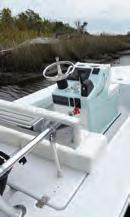









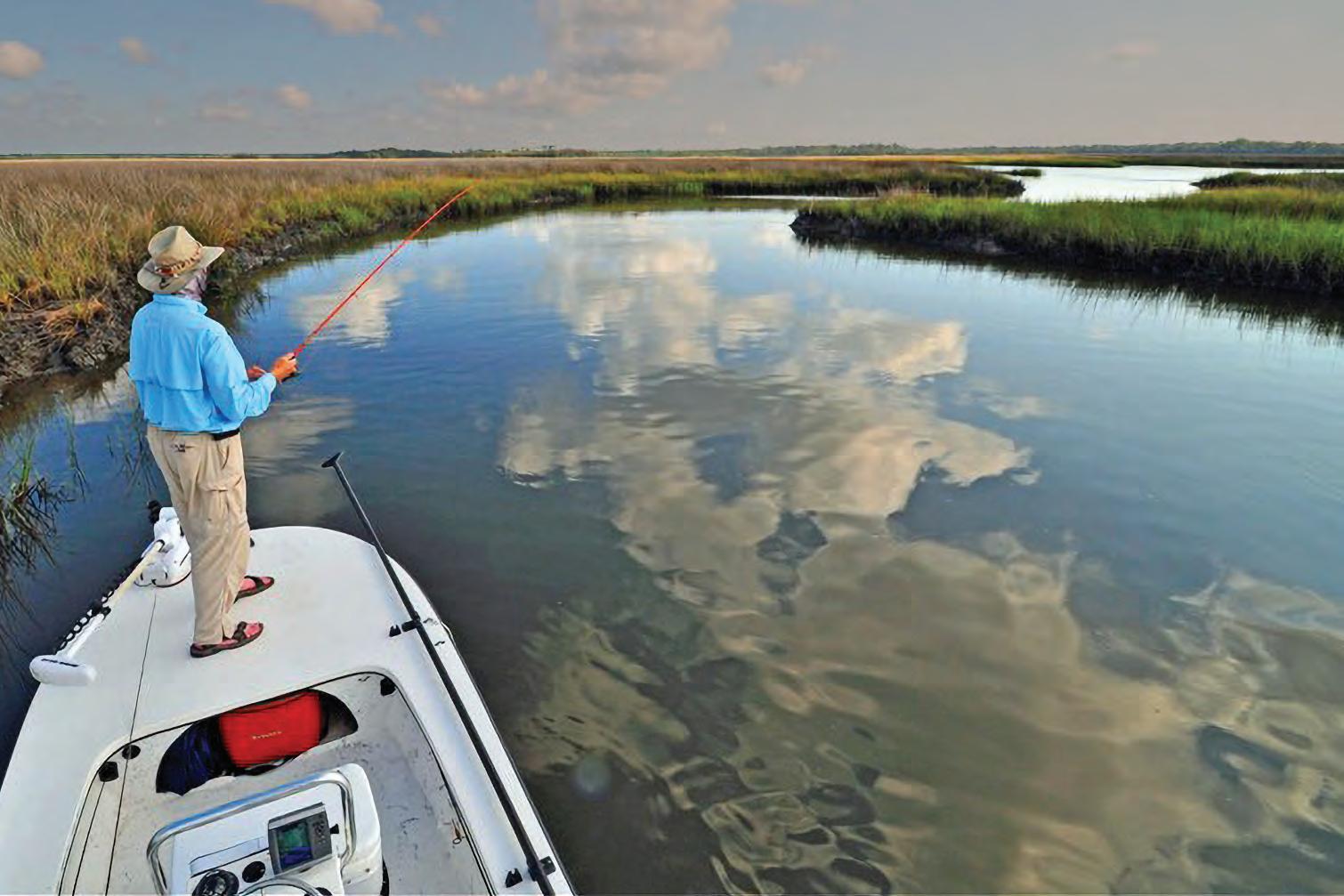
The year is 2024, and technology is getting better and better. Whether it be the retail tech business or the fshing industry, there are tools now available that a few years ago we would have never thought were even possible. One of those technologies is forward-facing sonar (FFS). Tere’s a lot of debate about FFS in the fshing these days, but there’s no denying it’s an amazing tool when used correctly.
I have been using this technology since its earliest stages, and catching fsh while looking at my screens has become one of my favorite ways to fsh. It is extremely cool to watch a fsh eat your lure in real time, and it can also teach you a tremendous amount about what is happening under the water. Not only do I use this tech to fnd and catch fsh, I use it to pinpoint bait and areas with life, fnd sweet spots and diferentiations in an area, and eliminate dead water much faster ever before.
Figuring out how to use this new technology can be a little frustrating at frst if you don’t quite understand what’s going on. Spending time on the water, doing as much research as possible or getting someone experienced to teach you are the best ways to get an upper

hand. Fishing lakes where catching fsh isn’t very hard in general helped
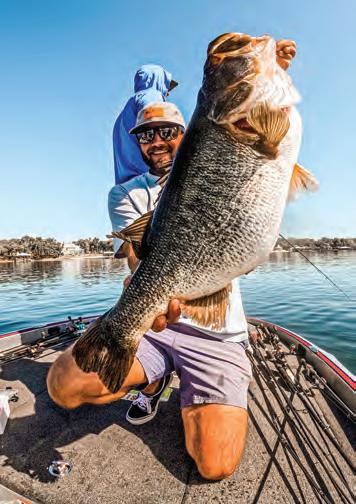
me tremendously with deciphering what I saw using FFS. Smallmouth fshing in the north country was a big helper, as these fsh are aggressive and you get many opportunities to present baits and dial in your skills.
Another thing that helps you understand the picture on your screen is objects that are visible above the water. Point your transducer at a bridge, dock, tree or grass, and picture in your head what should be under the water while also watching your screen. Tis will help beginners dial in settings and get a better understanding of what is displayed. It takes time, patience and dedication to learn, but don’t get frustrated and try to have fun with it.
Tere are varied opinions on forwardfacing sonar and its place in the fshing industry, but it isn’t going away, it will only get better! Some of the coolest things I’ve witnessed and some of my best fshing days were due to the electronics on my boat.
Spending the time to learn how to use FFS is well worth the efort. Te technology is dominating pretty much every tournament right now, and it absolutely revolutionized the way I break down a body of water.
Tere are many resources out there to help you in your learning process and people like me who are always willing to answer questions. Don’t be afraid to reach out, tight lines!
Tyler Woolcott is a professional tournament angler and guide. Check out his website at www.tylerwoolcottfshing.com.

It’s well known that some of the best kingfsh fshing starts with a livewell full of frisky baits. Unfortunately, catching them can eat up much of your fshing time. Afer that, it can be hours of bump trolling waiting for a fsh to hit. Fortunately, for those who just want to head out for a couple hours of fun and blistering runs, it can be accomplished with artifcials. Besides getting you straight to the fshing, you can cover a lot more ground by pulling hardware, and it is not nearly as tedious.
Like using live bait, wire leader is crucial. Kingfsh have razor sharp teeth that will go through even stout mono with little efort. I prefer single-strand wire and usually opt for at least #7 (80-lb.). Single strand tends to kink afer just one fsh, but that’s not always a problem when pulling big plugs, as they will pull the wire straight. Also, watch your split rings. Tey can weaken the loop where it attaches to the lure, so be sure to constantly inspect your connections. I like to cover many diferent depths in the water column when trolling. I

start with a shallow runner like the Nomad 190 AT that runs 3 to 5 feet deep, which I set way back. I also like the Nomad Madmacs that run just slightly deeper. I run it 30 to 50 feet in front of my shallow long-bait to facilitate turning. Ten I like to go deeper with a DTX Minnow 165. I run that close to the boat and right under the prop wash. Tis is hands down my most productive bait. I fnd speeds of 6 to 8 knots usually work well. Tis allows me to cover a lot of ground and is fast enough to elicit a strike. I ofen fnd any slower and the fsh don’t seem interested. Te other great thing about these lures is the hooks are very large, and they stick once they make contact.
When you’re trolling the deeper-diving DTX 165s, you will need a reel with some signifcant drag, as these big-lipped plugs take a lot to hold in place. Te Accurate BV600, with its dual drag system, is a great reel for the job. Te BV X76H matches perfectly with it and is a great multi-duty trolling rig that doubles as an awesome grouper rod. Even though you don’t need a super-light tip, like with live bait, a rod that gives is a plus with these sof-mouthed fsh.
As for spots, look for hard bottom that holds bait. Wrecks and reefs are great, too. It sometimes pays to make wider circles around these structures to get away from the barracudas.
With a few lures and some know-how, you can easily head out and catch some kings without dedicating an entire day to your eforts.
Will Schmidt is a seasoned tournament anglers who has been writing about fshing for more than three decades.


























The heritage of American Silver Dollars is rich and diverse, marked by stunningly beautiful designs, leading to an enduring desirability in the hearts of collectors around the world. In this iconic U.S. Silver Dollar set, spanning nearly 150 years, you’re getting FIVE American Silver Dollars issued over the last 15 decades that each reflect the history, culture and economic aspects of the United States.
Each of these U.S. Silver Dollars is sought-after by collectors individually, but this set includes every design of U.S. Silver Dollar in American history, issued from 1878 to 2024!
Morgan Silver Dollar: First struck 146 years ago in 1878, the Morgan has a historic legacy as the coin that helped build the American West. Minted until 1904, then again in 1921, this 90% silver coin with its iconic Lady Liberty design is the most collected vintage Silver Dollar in the world. Extremely Fine (XF) condition coin included in set.
Peace Silver Dollar: With a beautiful design memorializing peace following the end of World War I, the 90% silver Peace Dollar was intended as a one-year only release struck in 1921—but it proved so popular with the American people, it was struck until 1928, then again in 1934-35. Extremely Fine (XF) condition coin included in set.


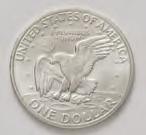





Eisenhower Dollar: The last circulating U.S. dollar coin, the Eisenhower Dollar, aka the “Ike Dollar,” was prized by Americans, with its design featuring war hero President Dwight D. Eisenhower, backed by an image symbolizing the Apollo II moon landing. First struck with silver 1971-1976, the Eisenhower Dollar in this set was struck in 40% silver for collectors, and you will receive a coin in Brilliant Uncirculated (BU) condition.



















Silver Eagle Type 1: The first-ever U.S. Silver Dollar minted in 99.9% silver, these coins were first minted in 1986 following President Ronald Reagan’s signing of the Liberty Coin Act into law on July 9, 1985, which authorized the U.S. Mint to strike America’s new silver bullion coin. This gorgeous Silver Dollar features the original, revered Type 1 “Heraldic Eagle” reverse design by John Mercanti, 12th Chief Engraver of the U.S. Mint. Brilliant Uncirculated (BU) condition coin included in set.
Silver Eagle Type 2: In honor of the popular 99.9% silver coin’s 35th anniversary in 2021, the Silver Eagle received a new, esteemed Type 2 “Eagle Landing” reverse design. This is the current issued coin by the U.S. Mint. Brilliant Uncirculated (BU) condition coin included in set.
SAVE with this Ultimate U.S. Silver Dollar Set! You’ll save both time and money on this 150 Year U.S. Silver Dollar Set, with FREE SHIPPING and a BONUS presentation case, plus a new and informative 150 Years U.S. Silver Dollars booklet! Call right now to get yours before they’re gone!












Ultimate U.S. Silver Dollars Set — Regular Price $249 - $199
Save $50.00 (over 20%) + FREE SHIPPING For fastest service call
